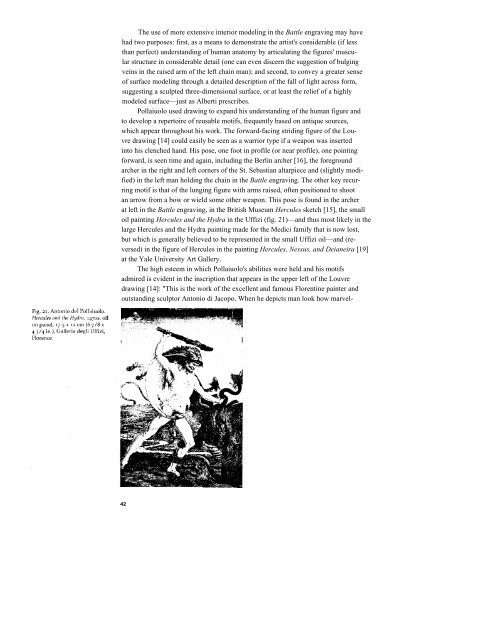Battle of the Nudes
Battle of the Nudes
Battle of the Nudes
You also want an ePaper? Increase the reach of your titles
YUMPU automatically turns print PDFs into web optimized ePapers that Google loves.
The use <strong>of</strong> more extensive interior modeling in <strong>the</strong> <strong>Battle</strong> engraving may have<br />
had two purposes: first, as a means to demonstrate <strong>the</strong> artist's considerable (if less<br />
than perfect) understanding <strong>of</strong> human anatomy by articulating <strong>the</strong> figures' muscu-<br />
lar structure in considerable detail (one can even discern <strong>the</strong> suggestion <strong>of</strong> bulging<br />
veins in <strong>the</strong> raised arm <strong>of</strong> <strong>the</strong> left chain man); and second, to convey a greater sense<br />
<strong>of</strong> surface modeling through a detailed description <strong>of</strong> <strong>the</strong> fall <strong>of</strong> light across form,<br />
suggesting a sculpted three-dimensional surface, or at least <strong>the</strong> relief <strong>of</strong> a highly<br />
modeled surface—just as Alberti prescribes.<br />
Pollaiuolo used drawing to expand his understanding <strong>of</strong> <strong>the</strong> human figure and<br />
to develop a repertoire <strong>of</strong> reusable motifs, frequently based on antique sources,<br />
which appear throughout his work. The forward-facing striding figure <strong>of</strong> <strong>the</strong> Lou-<br />
vre drawing [14] could easily be seen as a warrior type if a weapon was inserted<br />
into his clenched hand. His pose, one foot in pr<strong>of</strong>ile (or near pr<strong>of</strong>ile), one pointing<br />
forward, is seen time and again, including <strong>the</strong> Berlin archer [16], <strong>the</strong> foreground<br />
archer in <strong>the</strong> right and left corners <strong>of</strong> <strong>the</strong> St. Sebastian altarpiece and (slightly modi-<br />
fied) in <strong>the</strong> left man holding <strong>the</strong> chain in <strong>the</strong> <strong>Battle</strong> engraving. The o<strong>the</strong>r key recur-<br />
ring motif is that <strong>of</strong> <strong>the</strong> lunging figure with arms raised, <strong>of</strong>ten positioned to shoot<br />
an arrow from a bow or wield some o<strong>the</strong>r weapon. This pose is found in <strong>the</strong> archer<br />
at left in <strong>the</strong> <strong>Battle</strong> engraving, in <strong>the</strong> British Museum Hercules sketch [15], <strong>the</strong> small<br />
oil painting Hercules and <strong>the</strong> Hydra in <strong>the</strong> Uffizi (fig. 21)—and thus most likely in <strong>the</strong><br />
large Hercules and <strong>the</strong> Hydra painting made for <strong>the</strong> Medici family that is now lost,<br />
but which is generally believed to be represented in <strong>the</strong> small Uffizi oil—and (re-<br />
versed) in <strong>the</strong> figure <strong>of</strong> Hercules in <strong>the</strong> painting Hercules, Nessus, and Deianeira [19]<br />
at <strong>the</strong> Yale University Art Gallery.<br />
The high esteem in which Pollaiuolo's abilities were held and his motifs<br />
admired is evident in <strong>the</strong> inscription that appears in <strong>the</strong> upper left <strong>of</strong> <strong>the</strong> Louvre<br />
drawing [14]: "This is <strong>the</strong> work <strong>of</strong> <strong>the</strong> excellent and famous Florentine painter and<br />
outstanding sculptor Antonio di Jacopo. When he depicts man look how marvel-<br />
42
















